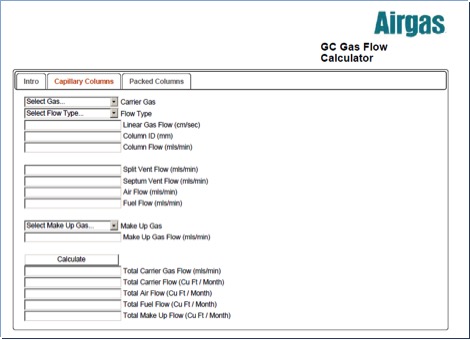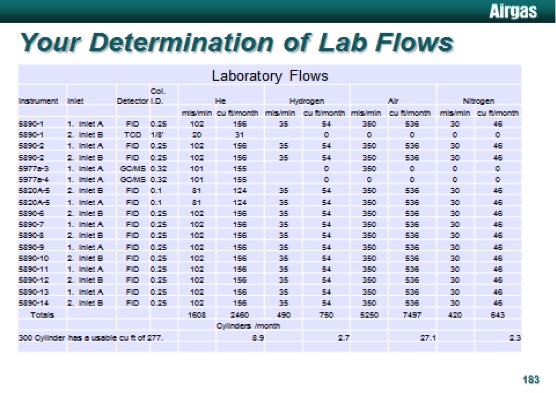
The gases used in a Gas Chromatography (GC) laboratory are expensive—it’s best not to waste them.
A lab full of GCs involves gases such as helium, nitrogen, hydrogen and air. In some labs, there are also specialty gases such as methane/nitrogen or other mixtures. So how do you know that you are using the correct amount of each gas?
Therefore, the range of flows for capillary columns goes from 81 to 140 mls/minute with helium at its optimum Linear Gas Rate of 20 cm/second or with hydrogen at 118 to 279 mls/minute at a Linear Gas Rate optimum of 40 cm/second. The flow range for hydrogen does not include the hydrogen needed for a Flame Ionization detector fuel.With Flame Ionization detectors, the air flow is between 300 to 400 mls/minute and the hydrogen flow as the fuel for the flame is between 30 and 40 mls/minute.
To properly evaluate gas flows in the lab you will need all of the flows from each instrument. Ideally, you want to compare these flows to each other, then compare them to your actual number of cylinders used. To do this, you first need to convert these flows from mls/minute to cubic feet of gas used in a months’ time. An average 300 cylinder of helium would contain 227 cubic feet of gas.

The Airgas GC Gas Flow Calculator is available at www.airgassgcatalog.com and will convert carrier gas, air and nitrogen flows from mls/minute to cubic feet/month—just enter your gas flows. This includes packed column and with capillary columns the column, split vent, septum purge and make-up gas flows. It also allows alternately entering the linear gas flow that is automatically converted to mls/minute from cm/second. These values are converted from mls/minute to cubic feet/month. This is important because, with these units, you can compare your gas usage to your monthly cylinder usage. See www.airgassgcatalog.com.
Using a typical helium cylinder (300) with 277 cubic feet of gas as an example, add up all your GC gas usage or estimate usages and divide that total by 277 cubic feet per cylinder. This should give you how many cylinders per month of helium you should use for your lab. You then compare this to the number of cylinders used per month of the gas.
We have done this repeatedly for labs across the country and found that actual cylinder usage per month is often two to three times the calculated usage. After making these calculations, we work with our customers to find leaks, which could be due to bad connections, leaking lines, bad regulators and wasteful cylinder changeout processes. After solving these problems, we are able to greatly reduce gas usage and improve the purity of the gas delivered to the GC. This reduces baseline problems, lengthens column life and increases sensitivity for the customer’s analysis.
Below is a sample listing of GC flows, a typical lab full of GCs and the type of gas flows you should expect.
